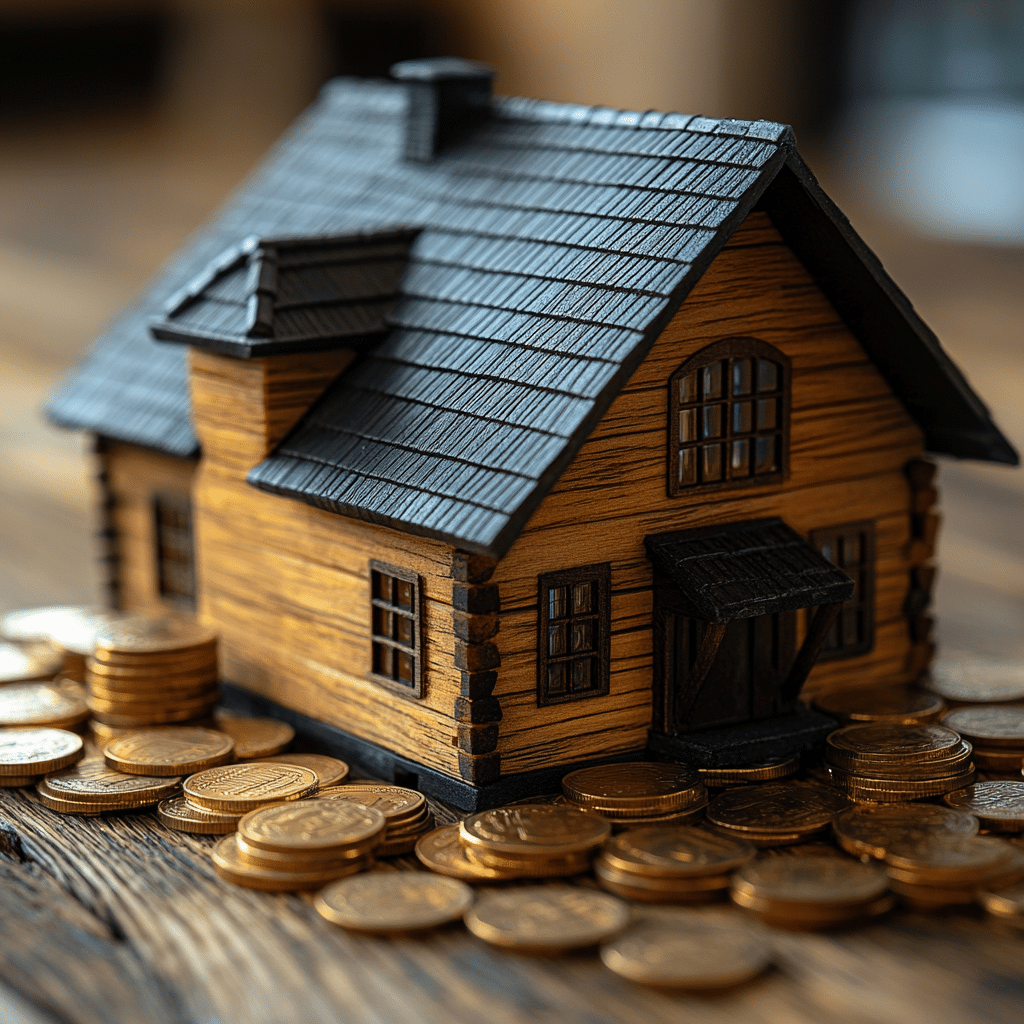When diving into the journey of homeownership, one of the first questions that often pops up is, how much is a downpayment on a house? This initial investment is critical and can vary widely based on a range of factors, from the type of loan you choose to the location of the property. Generally, downpayments range from 3% to 20% of the home’s purchase price. But guess what? As we head into 2024, some market trends may provide alternatives that can ease the financial burden, including options that require no downpayment for specific loan programs. So let’s break this down properly.

Understanding How Much Is A Downpayment On A House
First off, let’s get on the same page about what a downpayment is. It’s the amount of money you pay upfront when buying a home, and it shows the lender that you’re committed. A higher downpayment can mean better loan terms, so it’s worth paying attention to this detail.
Now, the traditional wisdom suggests that you should aim for a 20% downpayment. For a home priced at $300,000, that translates to a hefty $60,000 to fork over at the start. However, many first-time homebuyers may not have that much cash lying around. The good news here is programs like FHA loans only require a minimum downpayment of 3.5%, which could mean just $10,500 for the same house.
Additionally, certain loan programs are tailored for specific scenarios. Think about USDA loans, which promote rural homeownership with options for 100% financing. So if you’re in the market for a house in a designated rural area, you might not need any downpayment at all. With changing times, innovative solutions like these are offering more pathways to homeownership.

Top 5 Key Factors Influencing Your Downpayment
The mortgage type you choose is a major player in determining how much you need to set aside. For example, conventional loans generally require at least a 20% downpayment. On the flip side, FHA loans may let you slide in with as little as 3.5%. Let’s take a peek: with that same $300,000 home, a conventional loan needs $60,000 upfront, but an FHA loan would only demand $10,500.
Here’s where your credit score steps in as a deciding factor. Lenders use it to gauge risk: the higher your score, the lower the downpayment could be. If you’re rocking a score above 740, you might snag a conventional loan with just 5% down. However, borrowers with lower scores may find themselves ponying up a full 20% instead.
Housing markets are in no way uniform. Prices fluctuate, and depending on where you want to live, your downpayment can soar. Take San Francisco, where homes can easily top $1.5 million—the downpayment there could hit $300,000! On the other hand, if you’re eyeing a cozy place in Fort Wayne, Indiana, you might only need around $6,000 for that property priced under $200,000.
Various loan programs exist to assist buyers of all stripes. USDA loans offer 100% financing, making it possible to jump into a home sans any downpayment. This is particularly helpful for families in rural areas, as they might only need to cover the closing costs.
Don’t forget the resources for first-time buyers. Many states provide assistance programs that can drastically lower downpayment amounts. For instance, the California Housing Finance Agency has options that help eligible buyers with their downpayment, making the dream of homeownership a more attainable reality.
What is an Amortization Schedule and How It Relates to Your Downpayment
Let’s talk about the amortization schedule. This handy table lays out each monthly payment, breaking down the nitty-gritty of principal and interest over the life of your loan. Why does this matter? Understanding how a larger downpayment can shrink your monthly bills—and the total interest paid—is vital in this process.
Here’s an example for clarity. Imagine you take out a $300,000 mortgage with a 30-year fixed term at a 4% interest rate. If you put 20% down ($60,000), your monthly payment would hover around $1,145. However, drop that downpayment to just 5%, and your payment balloons to about $1,429. Not only will you pay more each month, but you’ll also end up shelling out a significantly heftier amount in interest throughout the loan term.
What Is Disbursed and Its Importance in Home Financing
Now, let’s tackle the concept of disbursement. This term refers to the release of funds in a financial transaction. In the mortgage world, this is crucial because it often includes the amount the lender hands over to seal the deal after your downpayment is made.
Why is understanding disbursement key? When considering how much is a downpayment on a house, it’s essential to remember that there’s more to the costs than just the downpayment. Closing costs can range between 2-5% of the home price. So, if you’re looking at a $250,000 house, and you’ve saved up a 10% downpayment of $25,000, don’t forget about those other expenses, which can easily add another $5,000 to $12,500 to your wallet.
Amortization: What Is It and How It Affects Monthly Payments
Amortization is all about slowly chipping away at your debt through regular payments. A good grasp of this concept illustrates why your downpayment is so critical. A larger upfront payment accelerates the reduction of the principal balance, meaning lower interest costs as your loan progresses.
Take a buyer with a $300,000 mortgage at 3% over 30 years. If they make a 20% downpayment, they might pay around $155,000 in interest over the life of the loan. But if they opt for only a 5% downpayment, that interest could spike to about $186,000. A greater upfront payment can really lighten the load, especially regarding monthly payments and total interest paid.
Innovative Wrap-Up
Treading the waters of downpayments can feel tricky, but it’s also crucial for achieving successful homeownership. By delving into the factors that determine how much is a downpayment on a house, like mortgage types and credit impacts, you can strategically plan for that new home. Armed with these insights, future homeowners can navigate the mortgage maze with confidence, ensuring they make informed decisions that lead to sound investments in their dream homes.
So remember, whether you’re looking into How much Does it cost To refinance Your home or trying to figure out What Does amortization mean, take it step by step. Information is power in this property game, so utilize the resources available to you and get ready to unlock the door to your new home.
How Much Is a Downpayment on a House: Fun Trivia and Interesting Facts
Myth-Busting Money Talks
So, how much is a downpayment on a house? While many believe it’s mandatory to fork over 20%, the reality is often more flexible. In fact, some programs allow as little as 3% down! This flexibility makes homeownership attainable for many folks, much like how aspiring digital nomads can find creative ways to fund their adventures. Just think about it: with the right planning, using your downpayment smartly could be as thrilling as exploring the world while working remotely.
Historic Shift in Homeownership
Here’s a fun fact: the average American’s downpayment has dropped significantly over the decades. Back in the 1970s, buyers typically put down around 25%. Fast forward to today, and you’ll see folks leveraging lower downpayment options or even exploring zero-down loans! Isn’t that mind-blowing? It kinda reminds you of how some of our favorite actors, like Josh Charles, navigate their careers. They don’t always follow the same path, yet still find success in various movies and TV shows. Similarly, future homeowners have a range of choices to explore beyond traditional downpayment norms.
What’s Your Height in Downpayments?
Speaking of options, did you know that your personal financial situation plays a huge part in determining the size of your downpayment? Just as Kylie’s height might influence her performance in sports, factors like credit score and debt-to-income ratio can dictate how much you need to save. A healthier financial profile often opens the door to lower downpayment requirements, making homeownership within reach. And for those who enjoy a good storyline, think about how every episode of “Heaven Official’s Blessing” reveals a new twist—every financial journey is just as unique and full of surprises!
The Bigger Picture
So, why should you care about how much is a downpayment on a house? Understanding this key component can help you make informed decisions about your mortgage journey, including your options for refinancing down the line. After all, knowing how to refinance a house can not only reduce your monthly payment but also help you build equity faster. Just like how the latest Dbz Films keep fans on the edge of their seats with their epic battles, your smart financial moves could lead you to triumph in homeownership!
Ultimately, how much is a downpayment on a house is more than just a number; it’s a stepping stone to your goals, and it’s worth taking the time to learn about your options.




